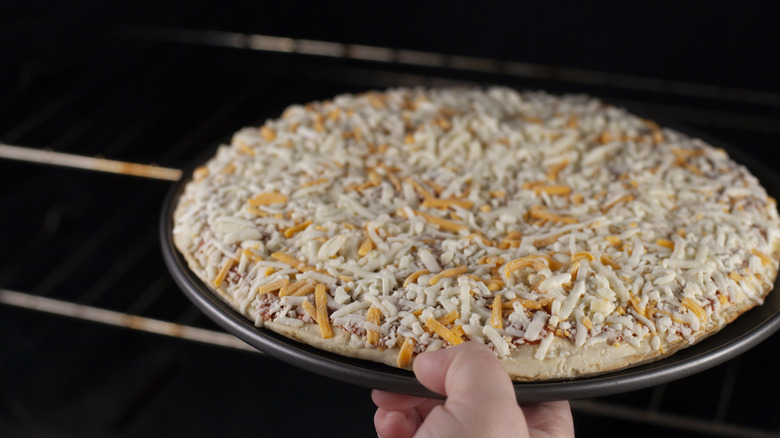Crack An Egg On Your Frozen Pizza To Totally Elevate Dinner
If you're trying to solve the daily riddle of what to make for dinner, a frozen pizza is a weeknight secret weapon that can save the day if you don't have the time or energy to make anything from scratch. It's also almost always significantly cheaper and faster than getting a pizza delivered, and you don't need any special cooking skills to get dinner on the table; just turn on the oven and follow the directions. Straight out of the box, however, most frozen pizzas are pretty blah; they often don't have enough cheese, flavor or toppings, and are considered an afterthought to takeout.
Frozen, grocery-store pizzas can get a bad rap, but just because they're easy and convenient doesn't mean they're strictly for college students. It takes almost no effort to elevate a frozen pizza from standard issue to something that's a little gourmet (and a little healthier), and you can usually use ingredients that you already have on hand. If you're looking to add a little something extra to upgrade your next frozen 'za, do what trendy chefs have been doing with almost everything from burgers to pasta in the last few years — add an egg or two.
Put an egg on it
Adding an egg to frozen pizza might seem a little weird at first, but if you think about it, eggs on pizza is not much different than eating eggs with toast and cheese for breakfast. In fact, an egg will punch up the protein factor, which will keep you feeling full and satisfied longer, as well as adding a creamy richness to the flavor —just like they do for ramen.
You can experiment with eggs on pizza pretty easily, it's really just a matter of cracking an egg and letting the oven do the work, and because all the ingredients are fairly inexpensive your kitchen trials are fairly low stakes. There are, of course, a few guidelines you can follow, which mostly comes down to timing.
Most standard grocery-store frozen pizzas are baked at around 450 degrees Fahrenheit for anywhere between 15 to 30 minutes. A baked egg will cook through in about that same amount of time at 350 degrees Fahrenheit, so depending on how cooked you want your pizza egg to get, start experimenting halfway through the pizza cooking process. All you have to do is open up the oven and pour the raw egg (or eggs) around on top and slide the pie back in the oven to finish.
Experiment until you find your favorite
If you find that your eggs are too cooked and you like a runnier yolk, wait until there are only about ten minutes left in the bake before you put the eggs on, and vice versa — put them on sooner if you would like your egg cooked through.
Keep your oven temperature in mind as well. There are lots of ways to elevate a frozen pizza, including baking it at a higher temperature than the directions to get a really crispy crust that's chewy inside — usually around 500 degrees Fahrenheit. Keep in mind that this high temp will cook your eggs faster, and might cause a little charring, so wait a little longer before putting the eggs in the oven. This is also true if you cook your pizza on a grill, as the inside with the lid down can reach temperatures of 550 degrees Fahrenheit.
Once you get your timing down, try adding eggs to all kinds of pizza combinations. You can take inspiration from restaurants that serve up pies with bacon, eggs and other breakfast standards. Or sneak a few eggs into dinner-worthy combos like prosciutto (or any kind of ham), mushrooms, and even anchovies. Now that egg prices have finally crashed, you can experiment as much as you like.


